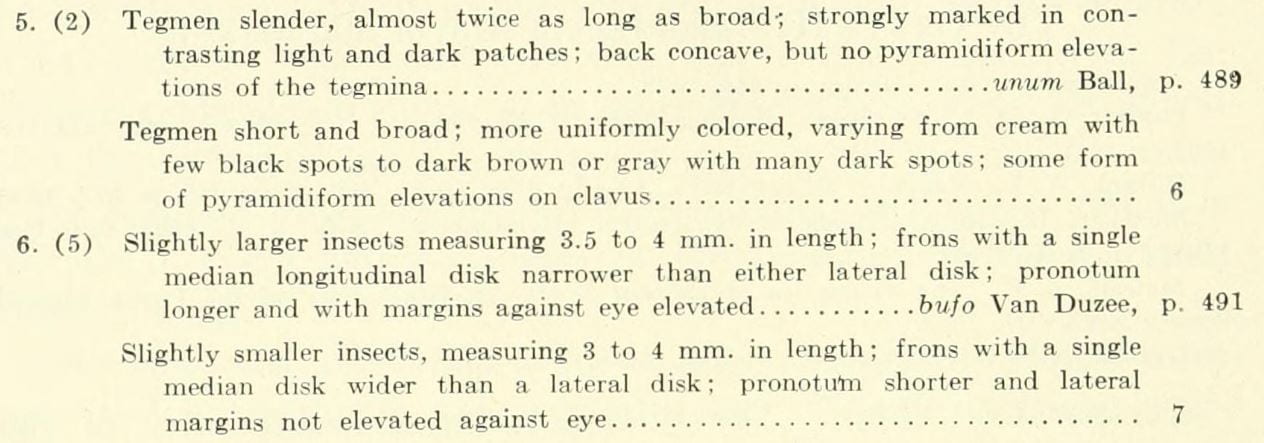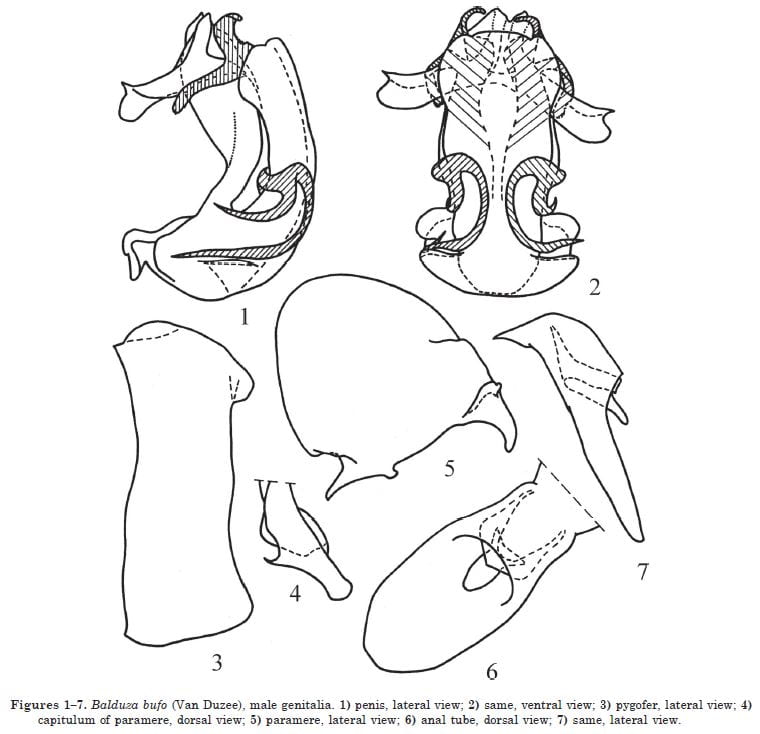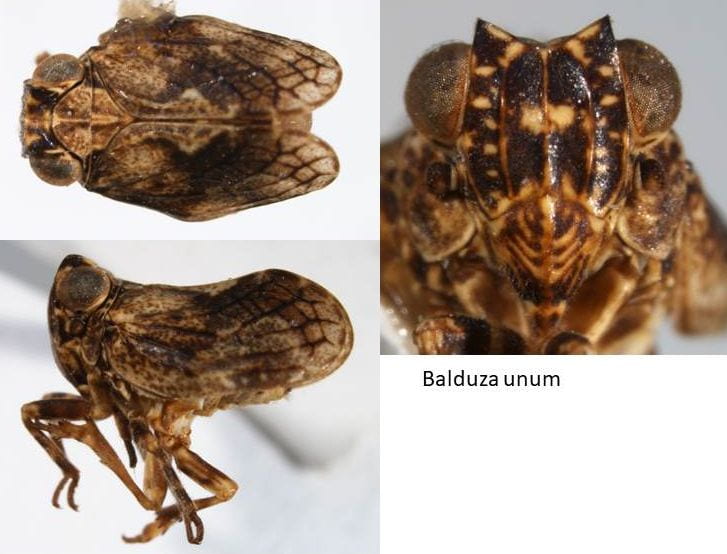[Return to North American Issidae]
Family Issidae Spinola, 1839
Subfamily incertae sedis
[Higher taxonomy revised by Wang et al. 2016; formerly placed in Issinae, Issini, subtribe Hysteropterina; see also Gnezdilov 2016]
Genus Balduza Gnezdilov & O’Brien, 2006
Type species (in original combination): Hysteropterum unum Ball, 1910.
Synonyms
None.
Distribution
Southwestern United States and Mexico.
Recognized species
There are two species currently assigned to this genus
Balduza bufo (Van Duzee, 1923) – USA: AZ; Mexico (Baja California, Baja California Sur, Sonora; Cerralvo [Jacques Cousteau] Island, Tiburón Island)
= Hysteropterum bufo Van Duzee, 1923: 192.
= Kathleenum bufo (Van Duzee, 1923); comb. by Gnezdilov, 2004: 2.
= Balduza bufo (Van Duzee, 1923); comb. by Gnezdilov & O’Brien 2006b: 221.
Balduza una (Ball, 1910) – USA: AZ, CA, CO, NM, NV, TX; Mexico (Durango, Nuevo León)
= Hysteropterum unum Ball, 1910: 43
= Balduza una (Ball, 1910); comb. by Gnezdilov & O’Brien 2006b: 221.
Economic Importance
Limited.
Plant associations
- Balduza bufo – Lycium (desert-thorn, Solanaceae)
- Balduza una – Ericameria nauseosa (Pall. ex Pursh) G.L. Nesom & Baird (rubber rabbitbrush, Asteraceae; as Chrysothamnus nauseosus)
Hosts from Wilson et al. 1994; plant names from USDA PLANTS or Tropicos.
Recognition
Hind wings absent or rudimentary, Body elongate (not rounded in dorsal view, vs Paralixes & Traxus), wings not strongly reticulate; Intermediate carinae of the frons present, raised; smaller species usually 4.4 mm or less; vertex not as deeply emarginate as Tylanira; intermediate carinae of frons converging dorsally; frons at the dorsal margin about as wide as tall at median carina (about 1.05x) with dorsal margin v-shaped; vertex about 2x wider than long in middle; Forewings patterned, irregularly speckled; dorso-anterior portion of head raised in lateral view; dorsal margin of forewing concave in lateral view; southwestern (not southeastern)
Here are the couplets in Doering 1938 that separate the 2 species (at the time part of Hysteropterum)

A portion of the key in Doering 1938 purporting to separate Balduza una and B. bufo (at the time in Hysteropterum)

Balduza bufo from Gnezdilov and OBrien 2006 Figures 1-7, male genitalia. 1) penis, lateral view; 2) same, ventral view; 3) pygofer, lateral view; 4) capitulum of paramere, dorsal view; 5) paramere, lateral view; 6) anal tube, dorsal view; 7) same, lateral view.
Online resources
Bugguide.
iNaturalist. (Genus not listed, link to family)
FLOW.
EOL.
GBIF.
BOLD.
GenBank.
3i.
Collecting
Adults are taken by sweeping or beating.
Molecular resources
There is data for Balduza una on Barcode of Life; there does not appear to be any data for this genus on Genbank.
Selected references
Ball, E. D. 1910b. New genera and species of Issidae (Fulgoridae). Proceedings of the Biological Society of Washington 23: 41-45.
Caldwell, J. S. 1945. Notes on Issidae from Mexico (Homoptera: Fulgoroidea). Annals of the Entomological Society of America 38: 89-120.
Doering, K. C. 1938. A contribution to the taxonomy of the subfamily Issinae in America north of Mexico (Fulgoroidea: Homoptera. Part II. University of Kansas Science Bulletin 25(20): 447-575.
Gnezdilov, V. M. 2004. Two new genera of the family Issidae (Homoptera: Cicadina: Fulgoroidea) from North America. Russian Entomological Journal 13(1–2): 1–2.
Gnezdilov, V. M. and L. B. O’Brien. 2006. Generic changes in United States Issini (Hemiptera, Fulgoroidea, Issidae). Insecta Mundi 20(3-4): 217-225.
Metcalf, Z. P. 1958. General Catalogue of the Homoptera. Fascicle IV, Fulgoroidea, Part 15, Issidae. Waverly Press, Inc., Baltimore, Maryland.
O’Brien, L. B. 1988. Taxonomic changes in North American Issidae (Homoptera: Fulgoroidea). Annals of the Entomological Society of America 81(6): 865-869.
Spinola, M. 1839a. Essai sur les Fulgorelles, sous-tribu de la tribu des Cicadaires, ordre des Rhyngotes. Annales de la Société Entomologique de France 8: 133-337.
Spinola, M. 1839b. Essai sur les Fulgorelles, sous-tribu de la tribu des Cicadaires, ordre des Rhyngotes. (Suite). Annales de la Société Entomologique de France 8: 339-454.
Van Duzee, E. P. 1923. Expedition of the California Academy of Sciences to the Gulf of California in 1921 – The Hemiptera (True Bugs, etc.). Proceedings of the California Academy of Sciences (Ser. 4) 12: 123-200.
Wilson, S. W., C. Mitter, R. F. Denno and M. R. Wilson. 1994. Evolutionary patterns of host plant use by delphacid planthoppers and their relatives. In: R. F. Denno and T. J. Perfect, (eds.). Planthoppers: Their Ecology and Management. Chapman and Hall, New York. Pp. 7-45 & Appendix.




